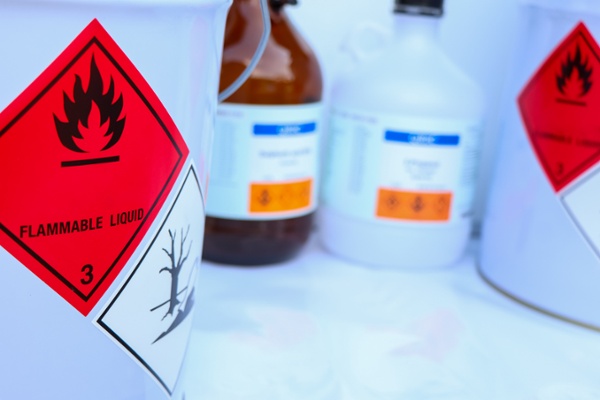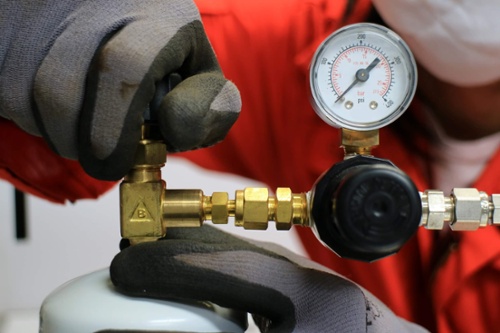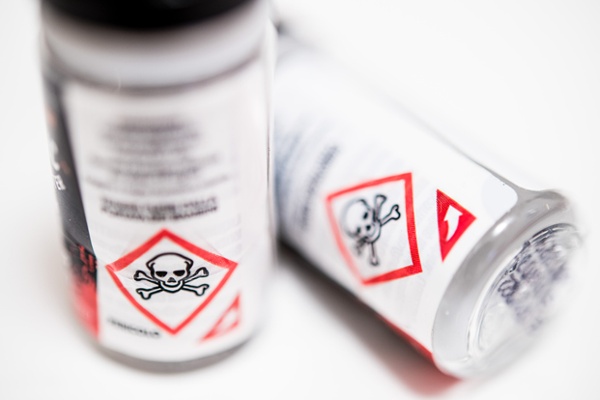Minor storage is a specific quantity of dangerous goods that can be stored without meeting the full requirements of the Australian Standards. However, this doesn’t mean that minor storage of dangerous goods means that no or little controls must be implemented. In this post, we’ll be detailing all the minor storage quantities for each class of dangerous goods – from Class 2 Gases right through to Class 8 Corrosives. We will also detail just some of the requirements related to the minor storage of each hazard class.
REMEMBER: You have a duty under WHS law to create a safe work environment for your staff and your community. Whenever you are storing any quantity of hazardous chemicals or dangerous goods, there is a risk that even a small amount could create a hazard. We highly recommend using compliant storage for all dangerous goods, with each class segregated to their own dedicated store.
What Are Minor Quantities Of Dangerous Goods?
The National Standard for the Storage and Handling of Dangerous Goods sets out requirements to ensure the effective control of these substances, to reduce risk to people, property and the environment.

To protect people, property and the environment from the risks associated with dangerous goods, the minor quantities for each class are determined.
The national code: Storage and Handling of Workplace Dangerous Goods (NOHSC:2017(2001)), provides a general definition of ‘minor quantities’:
“In the national dangerous goods framework, minor quantities of dangerous goods are aggregate quantities less than those listed in Schedule 1 of the national standard. Minor quantities of dangerous goods, at a premises, are storage and handling areas at which the national standard does not require placards to be displayed. –See NS/CoP 37–39 and Schedule 1 to the national standard.”
You can see full details of Schedule 1 by clicking this NOHS link
The basic concept of minor storage of dangerous goods is that the quantities are so small – or so scattered and separated – that the goods present little risk in an emergency.
Minor Storage Quantities in the Australian Standards
The quantities for minor storage for each dangerous goods class are clearly laid out in the Australian Standards.
Due to the different hazards associated with each dangerous goods class and division, there are different minor storage quantities listed in the relevant Standard.
In the next section of our post, we’ll look at the minor quantities of dangerous goods – from Class 2 Gases through to Class 8 Corrosive Substances. We’ll list the minor quantities for each class and offer an overview of some of the requirements of minor storage.
IMPORTANT: There is no safe amount of dangerous goods that can be stored without controls in the workplace. You must always ensure safety for your people, property and environment by storing dangerous goods in a way that reduces risk.
Minor Storage of Class 2 Gases
The maximum quantities of Class 2 Gases permissible for classification as minor storage can be found in Table 2.1 of the Australian Standard AS 4332 – The storage and handling of gases in cylinders.
| Class of Gas | Maximum Aggregate Water Capacity, L |
| Class 2.1 Gas | 500 |
| Class 2.2 Gas | 2,000 |
| Class 2.2 Gas with Class 5.1 Subsidiary Risk | 1,000 |
| Class 2.3 Gas | 50 |
*Refer to the Standard for the definition of water capacity for typical cylinder sizes.
Precautions that apply to the storage of gases in cylinders in minor quantities include, but are not limited to:
Indoor Minor Storage of Gases
- The store must be kept away from artificial sources of heat, such as steam pipes due to risk of cylinders overheating
- Keep area clear of combustible materials, refuse and vegetation at a distance of at least 3 metres to reduce risk of fire
- Ventilation must be adequate
- Segregation of gases applies within the store
- Floor must be flat, solid and constructed from non-combustible materials, draining away from cylinders

There are many requirements for the minor storage of Class 2 Gases.
Outdoor Minor Storage of Gases
- Class 2 Gases must be separated from other dangerous goods stores by a distance of at least 3 metres
- Outdoor minor storage must not be located within 1 metre from a door, window, duct or air vent
REMEMBER: Even small quantities of dangerous goods and hazardous chemicals can cause physical hazards, health hazards or chemical hazards. A single cylinder of flammable gas can explode if kept near heat; a container of toxic chemicals can pollute the environment; and a sole drum of corrosive chemicals can destroy property on your premises.
Minor Storage of Class 3 Flammable & Combustible Liquids
The maximum quantities of Class 3 substances permissible for classification as minor storage can be found in Table 2.1 of the Australian Standard AS 1940 – The storage and handling of flammable and combustible liquids.
The maximum quantity is listed in terms of:
- Location
- Flammable Liquids PG I, II or III
- Combustible Liquids C1 or C2
- Manufactured Products
For the puposes of this post, we are highlighting just a few of the most common locations for flammable liquids, including:
| Location | Flammable Liquids PG I or PG II | Flammable Liquids PG III | Combustible Liquids C1, C2 | Manufactured Products |
| Factories, workshops (indoors) | 1 L per 2 m2 if floor space - no more than 250 L in any 500 m2 area | 1 L per 1 m2 of floor space - no more than 500 L in any 500 m2 | 4 L per 1 m2 of floor space - no more than 2,000 L in any 500 m2 | In packages only - 2,000L |
| Shops | As for fatories and workshops - but no container for PG I or PG II liquid may exceed 20 L capacity | As for fatories and workshops - but no container for PG I or PG II liquid may exceed 20 L capacity | As for fatories and workshops - but no container for PG I or PG II liquid may exceed 20 L capacity | Flammable products: 10,000 L of which no more than 2,000 L are PG II - provided storage is closed packages, not to be opened (except for tinting of paints for immediate sale) |
| Service Stations (indoors) | 500 L total in packages. Packages kept in sales area must be unopened, not over 20 L capacity | 1,250 L total in tanks or packages | 3,000 L total C1 and C2 | As for factories, workshops |
| Hospitals (indoors) | 10 L per 50 m2 of floor space | 25 L per 50 m2 of floor space | 500 L total C1 and C2 per 50 m2 of floor space | The limit for manufactured products is the same as for a liquid of the same Packing Group |
| Construction sites | 2,500 L | 5,000 L | 10,000 L | As for shops |
| Open land (outdoors above ground) | 5,000 L | 5,000 L | 10,000 L | As for shops |
*Please refer to AS 1940 for a full list of minor storage requirements for all types of locations
Key precautions that apply to the storage of flammable and combustible liquids in minor quantities include, but are not limited to:
- Storage must be located on a floor above the building’s lowest floor
- Location of minor storage facility must not jeopardise the safety of any areas on lower levels
- Location must not impede firefighting operations
- Vapour build-up must be avoided, with storage area adequately ventilated
- Flammable vapours and spilt liquid must not escape to lower levels of the building
- Concentrated storage of liquids in an area must be avoided, so the fire load and potential rate of fire spread is reduced
Minor Storage of Class 4 Dangerous Goods
The maximum quantities of Class 4 Dangerous Goods for classification as minor storage can be found in Table 3.1 of the Australian Standard AS 5026 – The storage and handling of Class 4 dangerous goods.
Maximum Minor Storage Quantities in any 100 m2 Floor Area (kg or L)
| Premises Type | Category A | Category B | Category C | Category D |
| Residential | 0 | 0 | 1 | 5 |
| Commercial building, hospital or education establishment | 0.5 | 2.5 | 5 | 10 |
| Retail area | 0 | 0 | 10 | 20 |
| Lab, factory or workshop (except those located within premises covered by 2 above) | - | 5 | 10 | 20 |
| Warehouse | 5 | 10 | 20 | 40 |
*note: the above table is max minor storage quantities in any 100 m2 floor area
Key precautions that apply to the storage of Class 4 dangerous goods in minor quantities include, but are not limited to:
- Total quantity of Class 4 dangerous goods of all categories should not exceed max quantity specified for the least dangerous category stored
- Store must be in an area of non-combustible construction
- Adequate ventilation must be provided for all storage and handling areas of Class 4 dangerous goods
- Packages must be kept away from ignition sources and other dangerous goods that they are incompatible with or may react dangerously with by at least 3 metres
- Packages must be kept apart from foodstuffs by at least 3 metres
- Packages must be kept cool and away from sources of heat
- Static electricity must be controlled
- Spills or leaks must be cleaned up immediately
REMEMBER: Segregation is required for incompatible substances and those that react dangerously. Access your free magnetic dangerous goods segregation chart here.
Minor Storage of Class 5.1 Oxidizing Agents
The maximum quantities of oxidizing agents for classification as minor storage can be found in Table 2.1 of the Australian Standard AS 4326 – The storage and handling of oxidizing agents.
However, the minor storage of oxidizing agents in Section 2 of the Standard does not apply to ammonium nitrate.
Minor storage quantities, in packages or IBCs, allowable as minor storage are:
| Premises Type | Max quantity PG I, kg or L | Max quantity PG 2, kg or L | Max quantity PG 3, kg or L |
|
Residential (quantities for residential premises may be aggregated) |
5 | 25 | 100 |
| Farms | 50 | 250 | 25,000* |
|
All other (quantities for all other premises may be aggregated providing the total quantity of oxidizing agents is no more than 1,000 kg or L |
50 | 250 | 1,000 |
*farms storing PG 3 for minor storage must be at least 2 ha in size, with the oxidizing agnets not for retail sale; and the store is at least 10 m from any boundary or building.
**kg applies to solids, L applies to liquids
***this table doesn not apply to ammonium nitrate

Quantities for the minor storage of oxidizing agents are determined by the type of premises and packing group of substances.
Requirements for minor storage of oxidizing agents include, but are no way limited to, the following:
- Adequate ventilation must be provided
- If packages are opened, they must only be opened in a well ventilated area
- Spill retention and collection measures must be provided where packages are opened and their contents transferred or used
- Packages must be closed securely when not in use
- Packages must be kept on non-combustible surfaces not liable to attack or damage by the spilled chemicals
- Packages must be away from sources of heat by a distance of at least 3 metres
- Oxidizing agents must not be kept next to combustible materials or incompatible substances
- Dangerous goods of any other Classes or Divisions must not be kept in the same cabinet as oxidizing agents
- All spills and leaks must be cleaned up promptly.
REMEMBER: For further requirements relating to storage of oxidizing agents, please refer to the full set of requirements as listed in the Australian Standard for your dangerous goods class.
Minor Storage of Class 5.2 Organic Peroxides
The maximum quantities of organic peroxides for classification as minor storage can be found in Table 3.1 of the Australian Standard AS 2714 – The storage and handling of organic peroxides.
Section 2 Minor Storage of the Standard outlines what types of organic peroxides can be classed as minor storage:
This Section specifies the criteria for ‘minor storage’ of packaged organic peroxides of Types C, D, E and F, and the requirements for such storage. This Section does not apply to the storage of Type B organic peroxides in any quantity. - AS 2714
The quantities recognised as minor storage for organic peroxides are as per below:
| Packages of Types C, D, E and F | Individually containing no more than 5 kg or 5 L, and in total quantity not exceeding 20 kg or 20 L |
*units of kg apply to solids, L apply to liquids
Precautions for minor storage of organic peroxides (not including refrigerated) include, but are in no way limited to:
- Each organic peroxide needs to be stored below the maximum or recommended storage temperature as stated in the safety data sheet
- Spill and leaks must be cleaned up promptly. Spilled or leaked materials must not be returned to the original packaging
- Containers of organic peroxides must be kept on surfaces resistant to attack or damage, if the chemical was to leak or spill
- Containers must be stored away from direct heat and ignition sources by a distance of at least 3 metres
- Adequate ventilation is required in areas where containers are opened
- Adequate supply of water must be available for emergency use, as part of an eyewash station, for general first aid, and for washing down chemical leaks and spills
- Appropriate PPE must be used when handling containers or decanting from them
- Adequate ventilation must be provided for all storage and handling areas
REMEMBER: If organic peroxides require refrigeration during storage, there are further requirements that apply. See the Standard for full details.
Minor Storage of Class 6 Toxic Substances
The maximum quantities of toxic substances for classification as minor storage can be found in Table 2.1 of the Australian Standard AS NZS 4452 – The storage and handling of toxic substances.
| Premises Type | Max quantity PG I, kg or L | Max quantity PG II, kg or L | Max quantity PG III, kg or L |
| Residential | 1 | 10 | 100 |
| Farm | 10 | 500 | 3,500 |
| All other | 10 | 100 | 1,000 |
*units of kg apply to solids, L apply to liquids. Maximum quantites are the sum of the number of kg of solid + the number of L of liquid substances
**all listed quantities in this table may be aggregated
Toxic substances in minor storage quantities must adhere to a range of requirements including, but not limited to:
- Storage must be secured against unauthorised entry
- Supply of water must be available nearby for hygiene
- Adequate ventilation is required in storage and handling areas
- Packages must be separated from incompatible substances or those that may react dangerously
- Packages must be stored away from sources of heat
- Packages must be closed securely when not in use
- Packages must be kept in a way that avoids spillage
- Appropriate PPE must be worn by any person conducting product transfer operations
- Spills or leaks must be cleaned up immediately
- Wastes must be disposed of properly, as per Section 9 of the Standard

Toxic substances can cause harm to humans, animals and the environment.
Minor Storage of Class 8 Corrosive Substances
The maximum quantities of corrosive substances for classification as minor storage can be found in Table 2.1 of the Australian Standard AS 3780 – The storage and handling of corrosive substances.
| Premises Type | PG I, kg or L | PG II, kg or L | PG III, kg or L |
| Within a dwelling | 2.5 | 12.5 | 50 |
| Residential | 5 | 25 | 100 |
| All other | 50 | 250 | 1,000 |
*units of kg apply to solids, L apply to liquids. Maximum quantites are the sum of the number of kg of solid + the number of L of liquid substances
**total quantity of all Packing Groups must not exceed the maximum quantity specified for the LEAST dangerous Packing Group kept
Requirements for the minor storage of corrosive chemicals includes, but is no way limited to, the following:
- Supply of water must be available nearby
- Adequate ventilation is required in storage and handling areas
- Packages must be separated from incompatible substances
- Packages must be stored away from sources of heat
- Packages must be closed securely when not in use
- Packages must be kept in a way that avoids spillage
- Packages must be kept on surfaces which are resistant to damage if the corrosive substance leaks or spills
- Spillage-retention measures must be provided at locations where corrosive chemical packages may be opened or their contents transferred
- Appropriate PPE must be worn by any person conducting product transfer operations
- Spills or leaks must be cleaned up immediately
- Wastes must be disposed of properly, as per Section 9 of the Standard
Reducing Risk with Minor Storage of Dangerous Goods
As you can see by our brief overview of the requirements that apply to the minor storage of each chemical class, there are many safety measures to consider when storing smaller quantities of chemicals in your organisation.
Multiple risk controls – including providing spill containment, suitable surfaces for package storage, and isolation from sources of heat – are required.
The simplest way to store your minor quantities of dangerous goods is in a compliant safety cabinet or a small outdoor chemical store. This will ensure that all the requirements for storage are met and your goods won’t cause harm to your staff, property, environment or community.
To learn more about chemical safety and storage, why not access our free ebook? We’ll help you identify harmful chemicals at your site and offer solutions to ensure safe storage. Get your copy today to find out more about meeting your compliance and safety obligations.

Living life by the 4 C’s of marketing – communication, coffee, compliance… and more coffee – Leisa Andersen is Storemasta’s Content Marketing Manager. When she’s not writing, you’ll find her enjoying all the good things in life, including shopping, travel and gluten free donuts.
